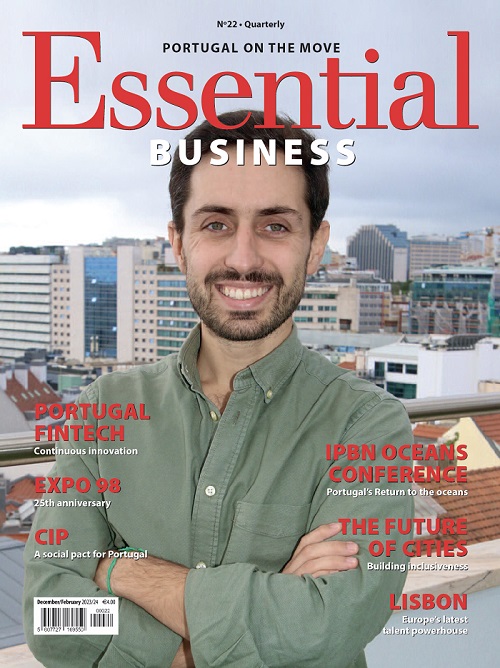Kopke – The Library Collection: tasting history
It’s not every day you get the chance to sample exquisite port wines that are a hundred years old or more. Essential Lisboa was invited by the oldest port wine brand in the world, Kopke, to taste history in the hallowed halls of Porto’s Palácio da Bolsa.
Picture it. You are in the Court Room of the bizarrely ornate Porto Trade of Commerce and former Stock Market, sat in a high-backed mid-1840s gothic oak chair — one of many arranged in rows above and either side of a tiled aisle. There is an immediate feeling of being in a chapel or an ancient academic institution.
But this is not a place of spiritual contemplation or classical academic discourse. This is a cathedral to commerce, a bastion of business as the towering murals of idealised medieval trading scenes reveal.
There is no chaotic hubbub and bustle of a modern stock market trading floor, just whispered voices in a dim light, heightening the tension provided by the heroic figures of muscled dock workers, counting house scribes and richly dressed 15th century merchants.
There is a palpable sense of anticipation that some ancient ceremony is about to take place; perhaps an anointment or Eucharist offering. In the middle of the aisle on a table covered in old ledgers and books stands an exquisite open book bound in brown Morocco leather. Inside there are three bottles nestled in aged velvet. The ceremony was about to begin and with it a sense of communion with history.
Three glasses are nearly arranged by a wine-tasting note book and a spittoon. We are guided through this ceremony of the senses — for this is really the only way one can describe it — by Kopke’s Director of Viticulture and Enology, Carlos Alves.
First served is the ‘Very Very Old Tawny’. Casked in oak in 1890 it is worth remembering that when this wine went into the cellars Queen Victoria still had 10 years to reign over one-third of the globe.
As it slumbered through decades of maturity, the Titanic would sink in 1912, the world would witness the horrific Great War of 1914-1918, a Revolution would topple Russia’s Tsar, banks would fall and stock markets crash, a Depression would envelop the globe in the 1930s and Hitler’s armies would march across Europe in the 1940s. Man would step onto the Moon in 1969 and another great queen, Elizabeth, would die after 70 years on the throne.
But what about actually tasting history? Would it be drinkable after 130 years? A suitably attired waiter decanted around two-and-a-half centimetres of the reddish-brown liquid into the glass. The rich, sweet and heady aroma of figs, brandy, spices such as cinnamon and cloves, vanilla and honey rose and swirled. The magic was unfurling.
The second wine, the ‘Vermouth’, was laid down in the cask in the early 1920s although the exact year of casking is not known because the ledgers are missing. In fact two of the wines are not considered legally port wines by the Porto and Douro Port Wines Institute. Created in 1933 it enforces the specifications and upholds the control of the quality of Port and Douro wines which must contain only wine to be considered a true port. Here the unmistakable aromas of dry figs, walnuts, plums and other fruits, but also orange peel and botanic herbs to give a herbaceous and spice-driven profile.
Carlos Alves, Director of Viticulture and Enology (pictured) explains that this is because it was usual to add some flavours in the form of herbs and spices which from 1922 was not permitted. Before then, adding medicinal herbs was permitted, which can be seen with Kopke’s ‘Quinine’ which was laid down in the early 20th century.
A medicinal tonic
The youngest wine, a 1937 vintage (The Hindenburg exploded, the Spanish town of Guernica was bombed by the Luftwaffe, and American aviation pioneer Amelia Earhart disappeared on her final round-the-world attempt that year just to add some international context), has perhaps the most interesting story of all.
The ‘Quinine’ (‘Quinado’ in Portuguese) would have been considered an aromatic tonic because of its use of quinine in the port wine. It was used throughout the 19th and 20th centuries as a prophylactic tonic against ‘agues’ or intermittent fevers caused by malaria, which ravaged both the Portuguese and British colonials in both Africa and India.
The bark of the cinchona tree was seen as effective in treating fever. It was first ground to a fine powder and then mixed into liquid (commonly wine or port) before consumption. Herbs such as cinnamon, cloves and oranges were used to mask the bitter unpleasant taste; a taste that is still tangible when sampling this amber Kopke vintage.
How effective it was is scientifically debatable since a glass of port wine infused with quinine would rarely stay in the blood for more than a couple of hours, so the amount of port wine with quinine you’d have to consume to treat malaria would leave you pretty sloshed around the clock. Still, there was a prevailing opinion that drinking a glass with meals had an inoculative effect and could prevent you for developing malaria. Consequently, it was shipped to the colonies in copious amounts and business boomed.
A 400-year legacy
Interestingly enough, given that Kopke was a German 17th century port wine producer, during the 30 Years War (1618-1648) while port wine was being shipped to the colonies by the crate load for its supposed anti-malaria effects, gin was provided to continental soldiers for its calming effects when going into battle; hence why the drink was termed ‘Dutch courage’, an expression we use today when taking a drink while faced with an arduous task.
Pedro Braga, CEO of Sogevinus (Kopke, Burmester, Cálem and Barros) says that the current generation of Kopke have a mission to preserve the historic legacy of the region and of the House of Kopke founded in 1638, and the oldest port wine producer in the world having been established well before the creation of the Demarcated Region of the Douro in 1756.
The event also had the mission to promote and value port wine. “It is why we are here today because we decided to launch a special edition ‘The Kopke Library Collection” to pay tribute to some of the wines in its historic library”, he says, adding that this limited edition was produced to coincide with Kopke’s 385th anniversary.
“There are not many wine producers around the world who have the responsibility to safeguarding and promoting a legacy spanning almost 400 years, and this moment has really touched me emotionally”, Pedro Braga adds with gravitas in his voice.
Pedro Braga is at pains to say that this limited edition of three wines, all distinct, were made to be enjoyed by connoisseurs. With a total production of around 1,100 litres each, these beautifully presented ‘bound books’ will, however, inevitably attract the interest of investors since they sell at €3,000 each and will probably be worth much more over time as many are consumed and lost to history.
Lost to history? Not entirely. Kopke never sells 100% of its production, because otherwise it would loose its library of knowledge and history laid down generation after generation, century on century. Today, you can still buy some of its slightly more accessible vintages such as its 1940 Tawny and White reserves or 1938 and 1961 Tawny reserves.
A first edition of Oscar Wilde’s novel ‘The Picture of Dorian Gay’ published the same year as ‘Very, Very Old Tawny’ was laid in oak will cost the collector anything between €5,000 and €7,000 in good condition at auction or in a London antique bookseller. My prediction is that within 30 years ‘The Library Collection’ might do similar. After all, just 385 ‘books’ have been produced, each hand crafted and bound to hold these rare elixirs from the end of one century and the early part of another which bear testament to some of the most inspiring and cataclysmic of world events.
Carlos Alves concludes by saying: “Of course, some will end up in the hands of investors, but my hope is that the buyers enjoy the wines because they are unique and we’ll never see the likes of these again”.
About Carlos Alves
Carlos has been director of viticulture and enology at Sogevinus since December 2022. Before that he clocked up 17 years experience as a winemaker and master blender for the same company since 2006. He has a degree from the University of Trás-os-Montes and Douro (UTAD) and a degree in agricultural management from the Beja Polytechnic Institute.
About Pedro Braga
Pedro Braga took the helm of Sogevinus Fine Wines, the owner of the Kopke and Calém brands in 2022.
As CEO he is responsible for looking after the brands Kopke, Velhotes, Calém, Burmester, Quinta da Boavista, Barros and Quinta de São Luiz.
Pedro Braga has the responsibility of continuing the work undertaken by his predecessor, Sérgio Marly who presided over the group at its most successful period in its history. With over 20 years of experience, he began his career in 2000 at Porto Calém, one of the companies that became part of Sogevinus, created that year.
Between 2004-2012 he was put in charge of production and in 2012 headed purchasing, quality, processes, logistics and premises management as director of operations at Grupo Sogevinus.
Appointed Chief Operations Officer (COO) in 2017, in 2022 he was appointed CEO by the Sogevinus shareholders.










